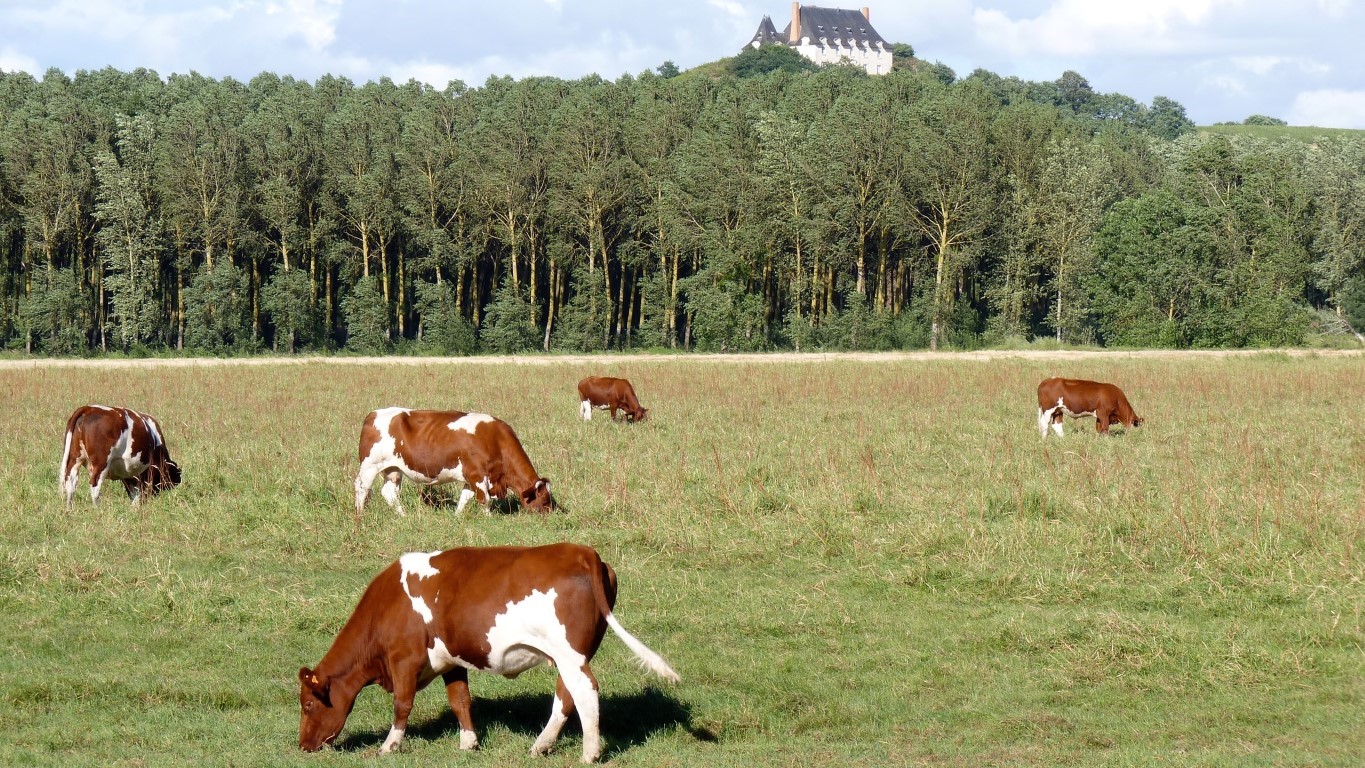 Cows in the French countryside, Angers, Loire valley
Cows in the French countryside, Angers, Loire valley
If you type raw milk vs pasteurized milk in your favorite search engine, you may discover dividing and intense debates on the topic. In the US, the debate is specially focused on health and nutritional values. In France, the debate is about raw milk versus pasteurized milk cheese taste and flavors, and food safety. Interestingly, France is the European country where people consume milk more in the form of dairy products (yogurt and cheese) than pure milk. In 2007, milk consumption was around 60L/person in France, while it was around 80L/person in the US.
Raw milk
Raw milk is just milk, uncooked and unprocessed milk. Its composition varies a lot depending on cow breed, health, nutrition, age and environment. Four components are dominant in milk: water, fat, protein and lactose. Minor components are minerals, enzymes, vitamins, dissolved gases and micro-organisms (yeast, molds, bacteria). As raw milk contains micro-organisms, it must be preserved at a low temperature and must be delivered to the consumer following very drastic sanitary precautions.
Raw milk can actually be described as an ecological system. This ecosystem depends on farming and milking practices and is generally composed of more than 200 micro-organism breeds, These micro-organisms are the main source of ferments involved in the process of raw cheese making.
Pasteurization
The word pasteurization comes from Louis Pasteur, a French biologist ad chemist of the 19th century. Pasteur spent his life studying bacterias. In particular, he discovered the principles of vaccination, microbial fermentation and pasteurization. Milk pasteurization consists in heating the milk to kill bacteria, among them harmful bacteria. There are different types of pasteurization, the most common being:
- Vat: milk is heated for 30 minutes at 63°C and then quickly cooled to 4°C. This type of pasteurization is the most expensive.
- HTST (High Temperature, Short Time): milk is heated at 72°C during 15 seconds: used by most dairy plants in the US today. This process kill 99.999% of viable micro-organisms, including yeasts, molds and bacteria.
- Ultra High Temperature (UHT): milk is heated between 135-150°C during 4-15 seconds. After this process the milk can be stored on the shelf at room temperature for several months.
Once milk is pasteurized there is no way that it can be turned into cheese without any inoculation of selected strains. Making cheese from pasteurized milk thus involves the introduction of industrial ferments (generally one or a few different micro-organisms).
Homogenization
Milk is an emulsion: fat globules are dispersed in skimmilk liquid. If you ever drank whole raw milk, you have probably observed a thin layer of cream on top. To get a better spread of fat in the milk, industrials have invented a mechanical process to homogenize the fat globules in the milk (the principle consists in making the fat globules very very small). Pasteurization tends to cluster the fat globules, causing them to separate even more than in raw milk. That explains why most of pasteurized milk that you can find at the supermarket are generally homogenized (you won’t see any cream on top).
So what?
There is few doubt that pasteurized milk is safer than raw milk. However, in industrialized countries that have certification programs and systematic microbiological quality controls throughout the supply chain, the food-borne outbreak risks due to dairy products are very low. In France, in 2017, 13,010 persons got food poisonned, among which 6 died. Among these infections, only 3% were due to milk and dairy products. Those oubreaks are related both to unpasteurized and pasteurized milk (for instance because of post processing contamination and thus lack of control).
Raw milk advocates defend that maintaining a high microbial diversity while using traditional cheese manufacturing methods, is key for developing rich and complex characteristics, as well as reducing the pathogen risks. In a journal article from (Montel et al., 2014), the authors cite several research works that have shown some benefits of microbial diversity against pathogens. For instance (Van Gysel et al., 2012) showed that E. coli and Staphylococcus aureus grow better in pasteurized than in unpasteurized human milk. Natural cheese microbiota can also protect cheeses against L. monocytogenes (on Livarot surface for instance). Inhibition of Listeria have also been observed but the exact mechanisms are still under research.
Cheese making from raw milk is hardly compatible with industrial processes (at least for now). But it is compatible with more local and traditional cheese production.
Obviously the study of milk is still ongoing research and we still have a lot to discover about raw milk microbiotes. Understanding the risks of using raw milk is important of course. But let’s not forget the centuries of cheese making tradition and let’s make rational choices. Eating raw milk cheese is nowadays very safe, and it is so much better! That’s why if I can find raw milk I will make my cheese with it. But… finding raw milk in the US is another story…
References & going further
- Report on foodborne diseases in France, Institut de Veille Sanitaire
- Milk consumption in France
- Milk consumption in the US
- Composition and nutritional value of raw milk, Guetouache et al. (2014), Issues in Biological Sciences and Pharmaceutical Research, vol.2, p.115-122
- Pasteurization, Wikipedia
- Homogenization process, University of Guelph, Canada
- Traditional cheeses: rich and diverse microbiota with associated benefits Montel et al., (2014), Int. J. of Food Microbiology
- Effects of Sterilization, Packaging, and Storage on Vitamin C Degradation, Protein Denaturation, and Glycation in Fortified Milks, H. Gliguem & I. Birlouez-Aragon, (2005), Journal of dairy science, vol.88, p.891-9